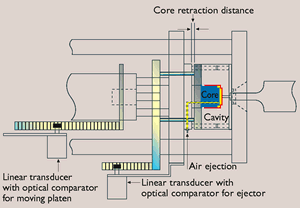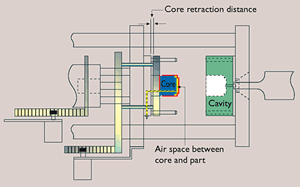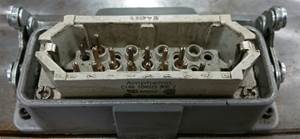How to Demold Parts Faster, With Less Stress and Surface Defects
You may need to unlearn what you always thought was the right way to get parts out of an injection mold.
You may need to unlearn what you always thought was the right way to get parts out of an injection mold. You will have to reprogram the sequence of steps for mold opening and ejection. But if you are making deep cup-shaped or box-shaped parts with little or no draft, especially ones with external undercuts or surface texture, the benefits of rethinking the demolding steps can be faster cycles and fewer rejects due to distorted, scratched, or marred products.
Paul E. Allen, president of Logic Corp., a supplier of mold-temperature controllers, cluster valves, and manifolds, has patented an approach he calls Incremental Cavity Ejection (I.C.E.). It uses the material shrinkage to help, rather than hinder, ejection of difficult parts.
Typically during molding the part shrinks around the core. The part is separated from the core using ejectors, air, and/or a stripper plate. However, if the part has shrunk too tightly onto the core, a number of potential part-removal problems can loom, says Allen.
"The core restricts the free shrinkage of the part, so stresses are created," he explains. In addition, high ejection or stripping forces may be required to push a cooled part off the core, and these forces can deform or wrinkle the part or impart added stresses.
At the same time, an undercut or textured exterior surface can make the parts difficult to remove from the cavity without deforming or marring the show surface of the part. Again, this occurs because the core restricts the ability of the part to shrink away from the cavity surface. The difficulties are magnified when parts have very low draft angles.
Up to now, solutions to these difficulties have included compromising part design to add more draft or using mold releases, slides in the tool, or highly polished molds—all of which add cost.
Simultaneous mold actions
Logic's I.C.E. process allows the molten plastic to relieve stresses in the mold while also reducing ejection force requirements. In some cases, air ejection may be adequate without ejector pins or a stripper plate.
The first goal of I.C.E. is to break the tight adhesion of the cooling and shrinking part to the mold core. The second goal is to allow the part to shrink radially away from the cavity wall. Both are achieved by partially withdrawing the core from the part while the part remains in the cavity.
When the core is partially retracted the initial stresses building up between the still molten center of the part and the cooling skin are allowed to relieve themselves. "Cooling and shrinkage now occurs radially across the diameter of core, instead of just across the thickness of the part," says Allen. The mold then opens fully, withdrawing the part from the cavity and allowing complete ejection off the core.
To break the adhesion between the core and the part the I.C.E. process requires a small movement of the core without fully opening the mold. A modification of the normal sequence program for the injection machine will be required. The incremental ejection distance off the core varies depending on part shape and surface, and resin used. "Incremental ejection of the part off the core can be carried out over a distance as little as 0.010 in. It has to be sufficient to break the grip of the part on the core but maintains the part engaged on the core for full withdrawal," says Allen. "Movement of the core and ejector or stripper plate is controlled using linear transducers and optical comparators—standard equipment on injection presses."
At the same time, I.C.E. requires that the part does not move during the initial core movement. The part can be held in the cavity using ejectors, a stripper plate, shop air, or combinations of these. The most common approach is to use the stripper plate and ejector system. When core retraction begins, the stripper plate or ejector system, which operates independent of the core movement, is moved forward at the same time and same speed as the core retracts. The ejector movement holds the part against the cavity. Any molding machine with true "eject-on-the-fly" capability can be utilized, says Allen.
Users can also employ shop air piped through the core to hold the part to the cavity while the core retracts. Logic has developed an auxiliary air-control device for this purpose.
This process requires that the moving and stationary mold halves be parallel. "You can mold parts with a zero draft angle, but the molds have to absolutely straight," Allen says. He prefers using the tiebars and leader pins to keep the molds in line, instead of just cam locks.
A big benefit with I.C.E. is that parts can be ejected hotter because there is less danger of distortion. This can trim overall cycle time.
What a user says
Logic licenses the I.C.E. process, including know-how for determining when to activate core and ejector movements and/or the air system. The patent (U.S. #5,932,164) was issued Aug. 3, 1999. So far, only a small handful of companies have used I.C.E, including Tupperware's Hemingway, S.C., facility, and custom molders Whirley Industries of Warren, Pa., BPW Plastics of Wilbraham, Mass., and Prototype & Plastic Mold Co., Inc., Middletown Conn.
Prototype & Plastic Mold, a $6-million/yr molder of parts for military, medical, and industrial applications, has used I.C.E to produce a military battery cell casing of polysulfone. The part measures around 6.5 x 3 in. x 6.5 in. deep with only 0.15º of draft. Initially, Prototype Plastics used a three-part mold with a split cavity. But demolding difficulties still generated up to 20% scrap parts.
Use of I.C.E with a stripper plate and 100-psi shop air allowed use of a standard two-part mold, which was 30% to 35% less expensive to build, says Bruce Silver, process engineer. Further cost savings came from using a lower level of polish and eliminating the use of a release agent on the core. Cycle time was trimmed by 33%, and because the part's internal stresses are relieved in the mold, a secondary annealing step could be eliminated, Silver says.
Related Content
Know Your Options in Injection Machine Nozzles
Improvements in nozzle design in recent years overcome some of the limitations of previous filter, mixing, and shut-off nozzles.
Read MoreInjection Molding: Focus on these Seven Areas to Set a Preventive Maintenance Schedule
Performing fundamental maintenance inspections frequently assures press longevity and process stability. Here’s a checklist to help you stay on top of seven key systems.
Read MoreBack to Basics on Mold Venting (Part 1)
Here’s what you need to know to improve the quality of your parts and to protect your molds.
Read MoreHot Runners: How to Maintain Heaters, Thermocouples, and Controls
I conclude this three-part examination of real-world problems and solutions involving hot runners by focusing on heaters, thermocouples, and controls. Part 3 of 3.
Read MoreRead Next
People 4.0 – How to Get Buy-In from Your Staff for Industry 4.0 Systems
Implementing a production monitoring system as the foundation of a ‘smart factory’ is about integrating people with new technology as much as it is about integrating machines and computers. Here are tips from a company that has gone through the process.
Read MoreBeyond Prototypes: 8 Ways the Plastics Industry Is Using 3D Printing
Plastics processors are finding applications for 3D printing around the plant and across the supply chain. Here are 8 examples to look for at NPE2024.
Read More






















